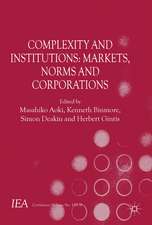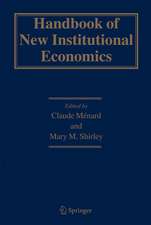Econometric Models of Asian Link
Editat de Shinichi Ichimura, Mitsuo Ezakien Limba Engleză Paperback – 30 iun 1985
Preț: 394.29 lei
Nou
Puncte Express: 591
Preț estimativ în valută:
75.45€ • 80.68$ • 62.91£
75.45€ • 80.68$ • 62.91£
Carte tipărită la comandă
Livrare economică 18 aprilie-02 mai
Preluare comenzi: 021 569.72.76
Specificații
ISBN-13: 9784431700074
ISBN-10: 4431700072
Pagini: 352
Ilustrații: XIV, 334 p.
Dimensiuni: 170 x 244 x 18 mm
Greutate: 0.56 kg
Ediția:Softcover reprint of the original 1st ed. 1985
Editura: Springer
Colecția Springer
Locul publicării:Tokyo, Japan
ISBN-10: 4431700072
Pagini: 352
Ilustrații: XIV, 334 p.
Dimensiuni: 170 x 244 x 18 mm
Greutate: 0.56 kg
Ediția:Softcover reprint of the original 1st ed. 1985
Editura: Springer
Colecția Springer
Locul publicării:Tokyo, Japan
Public țintă
ResearchDescriere
This is the first outcome of our effort in ASIAN LINK PROJECT to construct the econometric models of Asian developing countries and analyze their inter-dependence with major trading partners, the United States and Japan. The model we present here is called Asian Link System. The countries in this system include Korea, Taiwan, Hong Kong, China, the Philippines, Thailand, Malaysia, Singapore, Indonesia, Japan and the United States. They are covered by national models. The rest of the world is divided into several regions and treated by simple proto-type models. The main characteristics of Asian Link System are to deal with the inter-dependent relations between Asian developing countries on the one hand and Japan and United States on the other hand. Here are presented these national models and the Asian Link System with the underlying statistical data, so that any econometrician can re-estimate our models and check the results of our research work. Nowadays most articles and books in econometrics report only the final results or conclusions of research so that no other econometrician can re-calculate or re examine the findings. This is very serious in the empirical research, because as theorists may make mistakes, positive economists do commit errors or miss some possible considerations. Unless statiscal data are offered, other econometricians cannot make suggestions or improve the models. This is the main reason why empirical research in econometrics or applied econometrics are not making substantial progress in recent years.
Cuprins
1 A Survey of Econometric Model-Building in East and Southeast Asia.- 1. Econometric Models for Developing Countries.- 2. National Econometric Models.- 2 Hong Kong Model.- 1. Introduction.- 2. The Structure of the ERC Model.- 2.1 Personal Consumption Expenditure.- 2.2 Fixed Investment.- 2.3 Foreign Trade Sector.- 2.4 Manufacturing Sector.- 2.5 The Price Determination.- 2.6 The Monetary Sector.- 2.7 Taxes (TI, TD).- 3. The 1983 Version of Estimated Equations.- 4. Simulation of the ERC Model.- 5. Impact and Dynamic Multipliers.- 3 Taiwan Model.- 1. Introduction 3.- 2. The Model.- 3. Discussions on Behavioral Equations.- 3.1 Private Consumption.- 3.2 Private Fixed Investment.- 3.3 Inventory Investment.- 3.4 Export.- 3.5 Import.- 3.6 Depreciation, Tax and Transfer Payment.- 3.7 Price.- 3.8 Potential GDP.- 4. Test of the Model.- 5. Policy Simulation.- 5.1 A 10% Sustained Devaluation of NT.- 5.2 A One Billion NT Increase in Public Investment.- 6. Conclusion.- 4 Korea Model.- 1. Introduction.- 2. Model.- 2.1 General Description of the Model.- 2.2 Workings of the Model.- 2.3 The Results of Estimation.- 3. The Properties of the Model.- 3.1 Error Analysis.- 3.2 Multiplier Analysis.- 4. Conclusion.- 5 The Philippines Model.- 1. Introduction.- 2. Model Specification.- 2.1 Real and External Sector.- 2.2 Financial Sector.- 3. Estimation.- 4. Results / Findings.- 5. Evaluation of the Model: Ex-post or Historical Simulation.- 6. Dynamic Multiplier Analysis and Policy Simulation.- 7. Conclusion.- 6 Thailand Model.- 1. Introduction.- 2. The Model.- 2.1 Description of the Model.- 2.2 Production.- 2.3 Imports Demand.- 2.4 Domestic Expenditure and Exports.- 2.5 Determination of Prices and Wage.- 2.6 Factors Income.- 3. Simulation.- 3.1 Final Test.- 3.2 Policy Simulation.- 4. Conclusion.- 7 Malaysia Model.- 1. Introduction.- 2. Brief Survey of the Literature.- 3. The Model Specification.- 4. Simulation.- 5. Policy Simulation.- 8 Singapore Model.- 1. Introduction.- 2. Structure of the Model.- 2.1 Expenditures in National Accounts (Block I).- 2.2 Exports and Imports in Real Terms (Block II).- 2.3 Employment, Wage and Prices (Block III).- 2.4 Income Distributions (Block IV).- 2.5 Money Supply (Block V or V’).- 3. Final Test and Shock Simulations.- 9 Indonesia Model.- 1. Introduction.- 2. The Model.- 2.1 General Structure of the Model.- 2.2 Discussion of Selected Individual Equations.- 3. Final Test and Policy Simulations.- Appendix to Chapter 9.- A. Alternative specifications for the Price Determination in the Real Sector.- B. Balance Sheets and Monetary Submodel.- 10 Japan Model.- 1. Introduction.- 2. The Model.- 3. Final Test and Policy Simulations.- 4. Concluding Remarks.- 11 The U.S.A. Model.- 1. Introduction.- 2. Structural Equations System of the U.S.A. Model.- 3. Simulation Analysis of the U.S.A. Model.- 4. Concluding Remarks.- 12 China Model.- 1. Trade-off Relations in Socialist Countries.- 2. An Outline of the Model.- 3. Simulation.- 13 Asian Link System.- 1. Introduction.- 2. The Asian Link System.- 2.1 The Trade Model.- 2.2 Country Models.- 2.3 Rest of the World Models.- 2.4 interface.- 3. Traceability of the System: 1972–1980.- 4. Policy Simulations: 1976–1980.- 14 A Program System to Solve Linked Econometric Models.- 1. Programs for Econometric Models.- 1.1 Data Preparation.- 1.2 Method of Loading a Model into Program.- 1.3 Model Simulation.- 2. Solution Program for Linked Model.- 3. Linksim Prograsm System at Kyoto University Center for SEAS.- 3.1 Preparation of National Models.- 3.2 Specification of Order for Solution.- 3.3 Table for Data Transfer.- 4. Conclusion.- Data Appendix.- 2 Hong Kong.- 3 Taiwan.- 4 Korea.- 5 The Philippines.- 6 Thailand.- 7 Malaysia.- 8 Singapore.- 9 Indonesia.- 10 Japan.- 11 The U.S.A..- 12 China.- 13 Asian Link System.- Author Index.

















